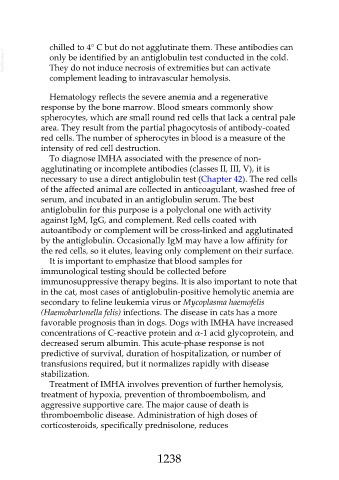Page 1238 - Veterinary Immunology, 10th Edition
P. 1238
chilled to 4° C but do not agglutinate them. These antibodies can
VetBooks.ir only be identified by an antiglobulin test conducted in the cold.
They do not induce necrosis of extremities but can activate
complement leading to intravascular hemolysis.
Hematology reflects the severe anemia and a regenerative
response by the bone marrow. Blood smears commonly show
spherocytes, which are small round red cells that lack a central pale
area. They result from the partial phagocytosis of antibody-coated
red cells. The number of spherocytes in blood is a measure of the
intensity of red cell destruction.
To diagnose IMHA associated with the presence of non-
agglutinating or incomplete antibodies (classes II, III, V), it is
necessary to use a direct antiglobulin test (Chapter 42). The red cells
of the affected animal are collected in anticoagulant, washed free of
serum, and incubated in an antiglobulin serum. The best
antiglobulin for this purpose is a polyclonal one with activity
against IgM, IgG, and complement. Red cells coated with
autoantibody or complement will be cross-linked and agglutinated
by the antiglobulin. Occasionally IgM may have a low affinity for
the red cells, so it elutes, leaving only complement on their surface.
It is important to emphasize that blood samples for
immunological testing should be collected before
immunosuppressive therapy begins. It is also important to note that
in the cat, most cases of antiglobulin-positive hemolytic anemia are
secondary to feline leukemia virus or Mycoplasma haemofelis
(Haemobartonella felis) infections. The disease in cats has a more
favorable prognosis than in dogs. Dogs with IMHA have increased
concentrations of C-reactive protein and α-1 acid glycoprotein, and
decreased serum albumin. This acute-phase response is not
predictive of survival, duration of hospitalization, or number of
transfusions required, but it normalizes rapidly with disease
stabilization.
Treatment of IMHA involves prevention of further hemolysis,
treatment of hypoxia, prevention of thromboembolism, and
aggressive supportive care. The major cause of death is
thromboembolic disease. Administration of high doses of
corticosteroids, specifically prednisolone, reduces
1238

